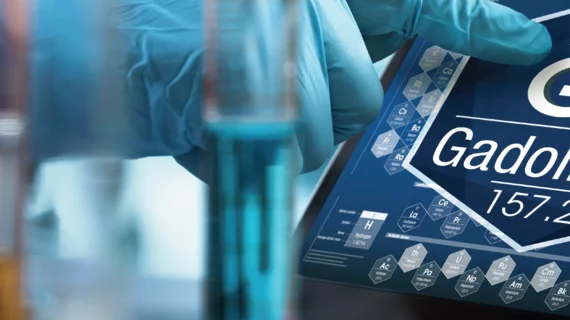Expert left 'astounded' by gadolinium discovery
The use of gadolinium-based contrast agents has been widely considered safe for many years, but new data out of the University of New Mexico suggest that the imaging agent’s physiologic reach may exceed what was previously believed.
While most experts in the field consider occasional use of gadolinium safe, its use has been the center of many heated debates and at least one high-profile lawsuit. The latest research out of UNM is likely to intensify these disputes.
Researchers there recently discovered that nanoparticles from gadolinium can sometimes infiltrate kidney cells on a microscopic scale. In some cases, these nanoparticles can trigger nephrogenic systemic fibrosis, a painful disease that can inhibit wound healing and organ function. In the worst cases it can prove fatal.
These findings are published in Scientific Reports, where internist Brent Wagner, MD, MS, and colleagues detailed the discovery of gadolinium nanoparticles in kidney cells by way of electron microscopy.
The team compared tissue samples from both human and mice models. Both had a contrast-naïve control group and a group of specimens that had been exposed to gadolinium prior to an MRI exam. After comparing the cohorts, Wagner was, by his own account, "astounded" by what he saw: gadolinium nanoparticles present in every tissue sample that had a history of gadolinium exposure.
In the paper, the group states their results “demonstrate gadolinium precipitation in human kidneys as a result of routine MRI contrast agent use.”
Wagner notes that, while GBCA use in MR imaging is frequent, toxicity side effects of the imaging agent’s exposure are not. He suggests that adverse reactions and/or side effects could be the result of gadolinium detaching from the chelating molecules, though it is unclear why this would occur.
Wagner suggests that one potential reason for GBCA side effects could be frequency of exposure.
“There are people who get five doses, and then you can start detecting the gadolinium inside the brain when you do an MRI without any contrast,” Wagner stated, adding that widespread use of gadolinium is a cause for concern for him, and that its use may be unnecessary in many cases.
Regardless, patients’ concerns with potential complications should not be dismissed, the study authors cautioned.
To view the University of New Mexico's release on the findings, click here.
To view the study abstract, click here.

